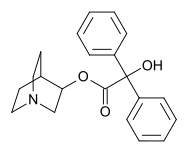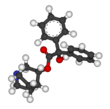3-Quinuclidinyl benzilate
3-Quinuclidinyl benzilate (QNB) — IUPAC name 1-azabicyclo[2.2.2]octan-3-yl hydroxy(diphenyl)acetate; US Army code EA-2277; NATO code BZ; Soviet code Substance 78[1] — is an odorless military incapacitating agent.[2] BZ is an antagonist of muscarinic acetylcholine receptors whose structure is the ester of benzilic acid with an alcohol derived from quinuclidine.
| |||
| Names | |||
|---|---|---|---|
| IUPAC name
1-azabicyclo[2.2.2]octan-3-yl hydroxy(diphenyl)acetate | |||
| Identifiers | |||
CAS Number |
|||
3D model (JSmol) |
|||
| ChEMBL | |||
| ChemSpider | |||
| ECHA InfoCard | 100.164.060 | ||
| MeSH | Quinuclidinyl+benzilate | ||
PubChem CID |
|||
| UNII | |||
InChI
| |||
SMILES
| |||
| Properties | |||
Chemical formula |
C21H23NO3 | ||
| Molar mass | 337.419 g·mol−1 | ||
| Melting point | 164 to 165 °C (327 to 329 °F; 437 to 438 K) | ||
| Boiling point | 322 °C (612 °F; 595 K) | ||
Except where otherwise noted, data are given for materials in their standard state (at 25 °C [77 °F], 100 kPa). | |||
| Infobox references | |||
Physiochemical characteristics
BZ is odorless. It is stable in most solvents, with a half-life of three to four weeks in moist air; even heat-producing munitions can disperse it. It is extremely persistent in soil and water and on most surfaces. It is slightly soluble in water, soluble in dilute acids, trichloroethylene, dimethylformamide, and most organic solvents, and insoluble with aqueous alkali.[3]
Effects
BZ affects both the peripheral nervous system (PNS) and CNS. BZ inhibits glandular secretions, leading to a dry mouth and foul breath. Cutaneous vasodilation and skin flushing may be noted due to decreased capillary tone. Hyperthermia is due to elevated body temperature secondary to inhibition of sweating and inability to dissipate heat. Vision loss is from a loss of accommodation reflexes and decreased depth of field secondary to ciliary muscle paralysis and mydriasis. Paralytic ileus is commonly seen as a result of anticholinergic toxicity. This can lead to fatal colic in equids. Urinary retention is also a common anticholinergic effect following exposure to BZ.
CNS signs of disorientation, agitation, tremor, ataxia, stupor, coma, and seizures may occur from inhibition of central muscarinic receptors. It is unknown whether animals hallucinate like people, but they do appear distressed. Rhabdomyolysis can be seen secondary to seizures and agitation. If severe, myoglobinuric renal failure could develop.
Other systemic signs may also occur. Sinus tachycardia is common. Moderate hypertension may occur, and tachypnea may be expected following an acute exposure. Nausea and vomiting may also occur.
Mechanism of action
BZ is an antagonist of muscarinic acetylcholine receptors. The characteristic that makes BZ an incapacitating rather than a toxic chemical warfare agent is its high safety margin (IC50/LD50) of around 40-fold (range 32 to 384 fold). It has an ID50 of 0.00616 mg per person (i.v.) with a probit slope of 9.2. The respiratory IC50 (median incapacitating dosage) for BZ is 110 mg·min/m³ (mild activity—15 l/min rate of breathing), whereas the LD50 is often estimated to be around 3,800–41,300 mg·min/m³.[4]
History
Invention and research
BZ was invented by the Swiss pharmaceutical company Hoffman-LaRoche in 1951.[5] The company was investigating anti-spasmodic agents, similar to tropine, for treating gastrointestinal ailments when the chemical was discovered.[5] It was then investigated for possible use in ulcer treatment, but was found unsuitable. At this time the United States military investigated it along with a wide range of possible nonlethal, psychoactive incapacitating agents including psychedelic drugs such as LSD and THC, dissociative drugs such as ketamine and phencyclidine, potent opioids such as fentanyl, as well as several glycolate anticholinergics.[6][7] By 1959, the United States Army showed significant interest in deploying it as a chemical warfare agent.[5] It was originally designated "TK", but when it was standardized by the Army in 1961, it received the NATO code name "BZ".[5] The agent commonly became known as "Buzz" because of this abbreviation and the effects it had on the mental state of the human volunteers intoxicated with it in research studies at Edgewood Arsenal in Maryland.[5] As described in retired Army psychiatrist James Ketchum's autobiographical book Chemical Warfare: Secrets Almost Forgotten (2006), work proceeded in 1964 when a general envisioned a scheme to incapacitate an entire trawler with aerosolized BZ; this effort was dubbed Project DORK.[8] BZ was ultimately weaponized for delivery in the M44 generator cluster and the M43 cluster bomb, until all such stocks were destroyed in 1989 as part of a general downsizing of the US chemical warfare program.
Alleged use
The U.S. Army tested BZ as well as other "psycho-chemical" agents on human subjects at Edgewood Arsenal in Maryland from 1955 to 1975, according to declassified documents.[9][10]
In February 1998, the British Ministry of Defence accused Iraq of having stockpiled large amounts of a glycolate anticholinergic incapacitating agent known as Agent 15.[11] Agent 15 is an alleged Iraqi incapacitating agent that is likely to be chemically either identical to BZ or closely related to it. Agent 15 was reportedly stockpiled in large quantities prior to and during the Persian Gulf War. However, after the war the CIA concluded that Iraq had not stockpiled or weaponised Agent 15.[12][13]
According to Professor Konstantin Anokhin at the Institute of Normal Physiology in Moscow, BZ was the chemical agent used during the 2002 Nord-Ost siege to incapacitate terrorists but due to overdose some of the hostages perished;[14] but many other agents have also been proposed, and none definitively confirmed.
In January 2013, an unidentified U.S. administration official, referring to an undisclosed U.S. State Department cable, claimed that "Syrian contacts made a compelling case that Agent 15, a hallucinogenic chemical similar to BZ,[15] was used in Homs".[16] However, in response to these reports a U.S. National Security Council spokesman stated "The reporting we have seen from media sources regarding alleged chemical weapons incidents in Syria has not been consistent with what we believe to be true about the Syrian chemical weapons program".[13][17]
Detection and protection
BZ is odorless and nonirritating with delayed symptoms several hours after contact.[2]
References
- Conant, Eve (22 November 2002). "More Questions Than Answers". Newsweek. Retrieved 15 April 2018.
- QNB: Incapacitating Agent. Emergency Response Safety and Health Database. National Institute for Occupational Safety and Health. Accessed April 20, 2009.
- US Army FM 3-9
-
- Goodman E (2010). Ketchum J, Kirby R (eds.). Historical Contributions to the Human Toxicology of Atropine. Eximdyne. p. 120. ISBN 978-0-9677264-3-4.
- Kirby, Reid. "Paradise Lost: The Psycho Agents", The CBW Conventions Bulletin, May 2006, Issue no. 71, pp. 2-3, accessed December 11, 2008.
- Possible Long-Term Health Effects of Short-Term Exposure To Chemical Agents, Volume 2: Cholinesterase Reactivators, Psychochemicals and Irritants and Vesicants. (1984)
- Ketchum - Chemical Warfare: Secrets Almost Forgotten (2006)
- Army’s Hallucinogenic Weapons Unveiled
- "Vets feel abandoned after secret drug experiments". CNN. March 1, 2012.
- "U.S. Army Chemical Research and Development Laboratories Technical Report" (PDF). U.S. Army. May 1964.
- Iraqi `zombie gas' arsenal revealed
- Intelligence Update: Chemical Warfare Agent Issues (Report). CIA. April 2002. Retrieved 28 January 2013.
We assess that Iraq never went beyond research with Agent 15—a hallucinogenic chemical similar to BZ—or any other psychochemical. Agent 15 became an issue after a 9 February 1998 British press release claimed that the UK had information, thought to be reliable, that Iraq had large quantities of this chemical agent in the 1980s. UNSCOM and intelligence information indicated that Iraq researched a number of psychochemicals, including Agent 15, BZ, and PCP; however, UNSCOM indicated it saw no evidence of Iraqi importation of large quantities, weaponization, procurement of militarily significant quantities of precursors, or industrial production of these agents
- Jeffrey Lewis (25 January 2013). "Why everyone's wrong about Assad's zombie gas". Foreign Policy. Retrieved 28 January 2013.
- https://www.theguardian.com/world/2002/oct/28/russia.richardnortontaylor
- Intelligence Update: Chemical Warfare Agent Issues
- Rogin, Josh (15 January 2013). "Secret State Department cable: Chemical weapons used in Syria". Foreign Policy The Cable. Retrieved 16 January 2013.
- "U.S. plays down media report that Syria used chemical weapons". Reuters. 16 January 2013. Retrieved 28 January 2013.

External links
- Erowid—BZ Vault
- eMedicine—Incapacitating Agents: 3-Quinuclidinyl Benzilate
- Possible Abuse of BZ by Insurgents in Iraq
- Center for Disease Control—BZ Incapacitating Agent
- Paradise Lost: The Psycho Agents by Reid Kirby
- Department of Defense—Agent BZ use in Hawaii April through June 1966.

